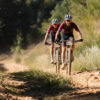It started with a desperate U.S. college football coach and his colleague, chemistry professor Robert Cade. In Florida’s tropical conditions, the Florida Gators players repeatedly showed signs of fatigue and cramping, so special attention was paid to energy & hydration. Chemist Cade mixed sugar and table salt into the player’s drink, briefly creating Gator-adelater the world’s first commercial sports drink.
Today, 58 years later, sports nutrition has outgrown its infancy as a serious science. Knowledge of energy supply and fluid or electrolyte replacement during exercise has grown significantly. But between euphonious marketing and complicated science, it has become difficult to identify its effective needs. An attempt to get to the heart of the matter:
Carbs Carbs Carbs!
Sport needs carbohydrates (CHO). A lot of sport needs more of itespecially during exercise. The target amounts are not necessarily to be achieved exclusively by a drink, but the more intense the exertion, the more liquid the carbohydrate supplythus reducing tolerance problems and accelerating energy absorption. Here’s how:
- Easy effort under 90 minutes: Water or 30g of carbohydrates per hour (simple sugar, syrup, sports drink powder, maximum 8% concentration = 80g/L).
- Easy efforts 90180min: 60g CHO/h (see above).
- Easy effort >180min: 80120g CHO/hour (glucose: fructose mixture = 1:0.8 or starches and glucose/fructose; max 12%).
- Intensive effort (hard training/competition) >60′: 80120g CHO/hour (see above).
Electrolytes: Really necessary and, if so, which ones?
Gatorade, to once again invoke the mother of all sports drinks, had always boasted to work best because they would efficiently replace sweat. Sweat, everyone knows that, is salty. This makes it obvious that we lose electrolytes (all minerals that carry an electrical charge in their dissolved form) when we sweat.
For far too long, however, many electrolytes have been overrated. In a healthy, balanced diet, the only thing we need is sodium in sports drinks (i.e. table salt, chemically: sodium chloride).
Sodium has many, important roles in our bodies, but at nearly 70g, we also have plenty of it. For the athlete, what matters most is its role in intestinal KH absorption and its osmotic activity (fluid balance).
In a recent work it was looked, when we need effectively above average sodium supply and thus, the fairy tale of the threatening salt deficiency somewhat the tooth pulled. Whether you need to continue to swallow salt tablets in series or whether the 500700 mg sodium per liter of a modern sports drink is sufficient should be explained briefly here:
Effort duration < 4 hours:
Normal salt intake is sufficient (no additional salt necessary due to above-average addition, salt tablets or similar)
Effort > 4 hours:
- < 70% sweat loss replaced (most training/competition conditions!); no additional sodium needed.
- > 70% sweat loss replaced (ultra events, multi-day formats); knowledge of sodium concentration in sweat helpful (laboratory analysis). If this is <1g/L (presumably 80% of all athletes) no additional sodium is necessary, whoever is on top of this should replace 3065% of the absolute sodium loss (calculated from the average amount of sweat, the average Na concentration and the duration of exertion).
Long sweat story short:
With generally adequate energy and hydration levels and a good sports drink, extra sodium is rarely needed. Athletes who are in extreme formats and/or extreme conditions would do well to determine their sweat rate accurately or even to analyze the sodium sweat concentration. However, this clearly concerns a distinct minority.
PS: Cramps are rarely a sign of electrolyte deficiencies! In this case, an insufficient fluid balance or simply an unaccustomed load for the body is the causean effective remedy is to drink pickle juice or to bite into a very hot chili pepperhave fun!
___________________________________________
Sweating in the Champions League Final:
A recent example from the Champions League final of a Manchester City player, for example, shows that in the warm and humid climate of the Bosphorus, a whole 1.2 liters are sweated in one hour and thus 780mg of sodium (that would be 650mg/L).
Since in a professional game with few interruptions the fluidloss is hard to compensate, said player does not need extra sodium and his normal sports drink and possibly solid food during the half-time break are sufficient.





